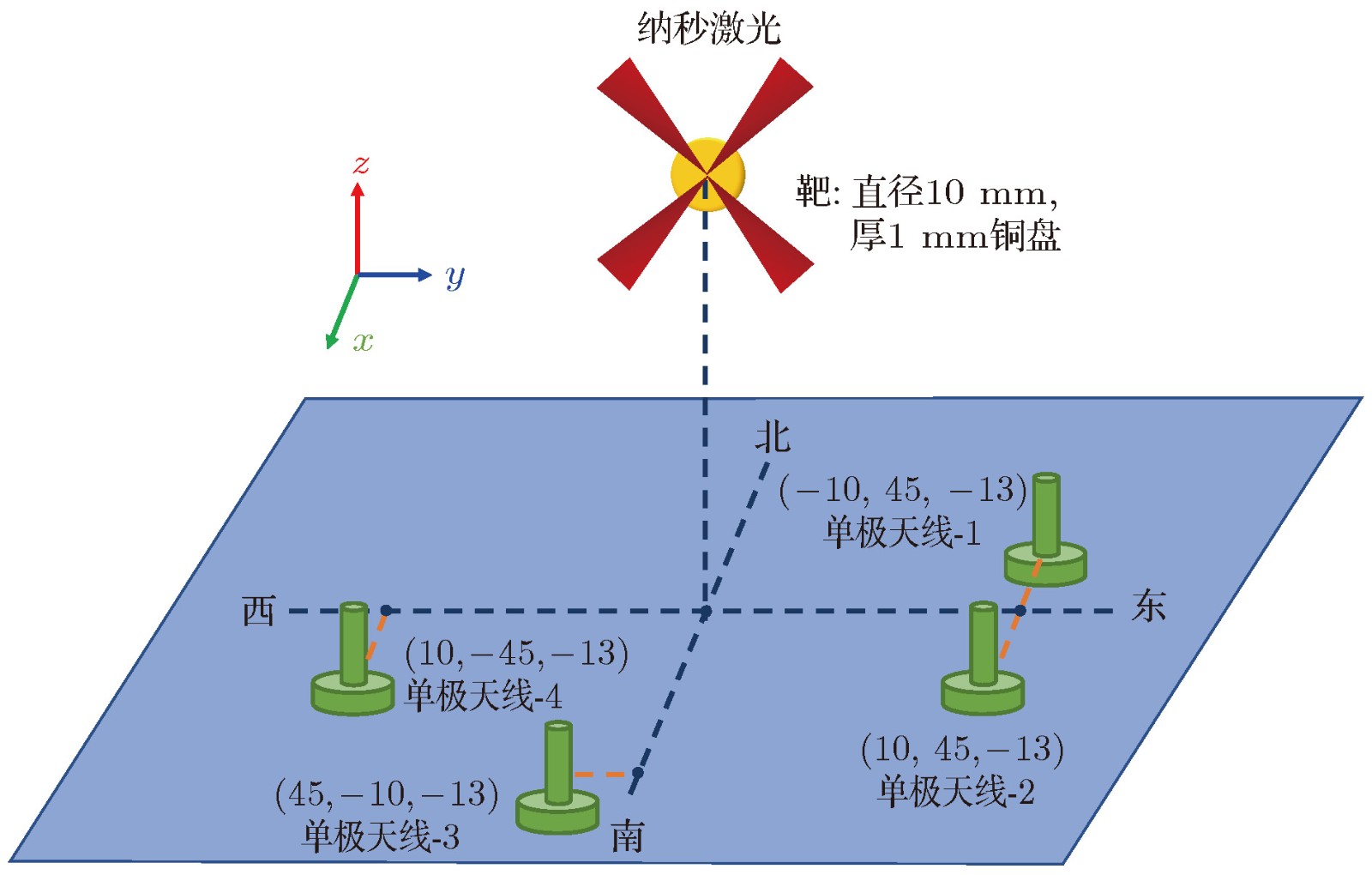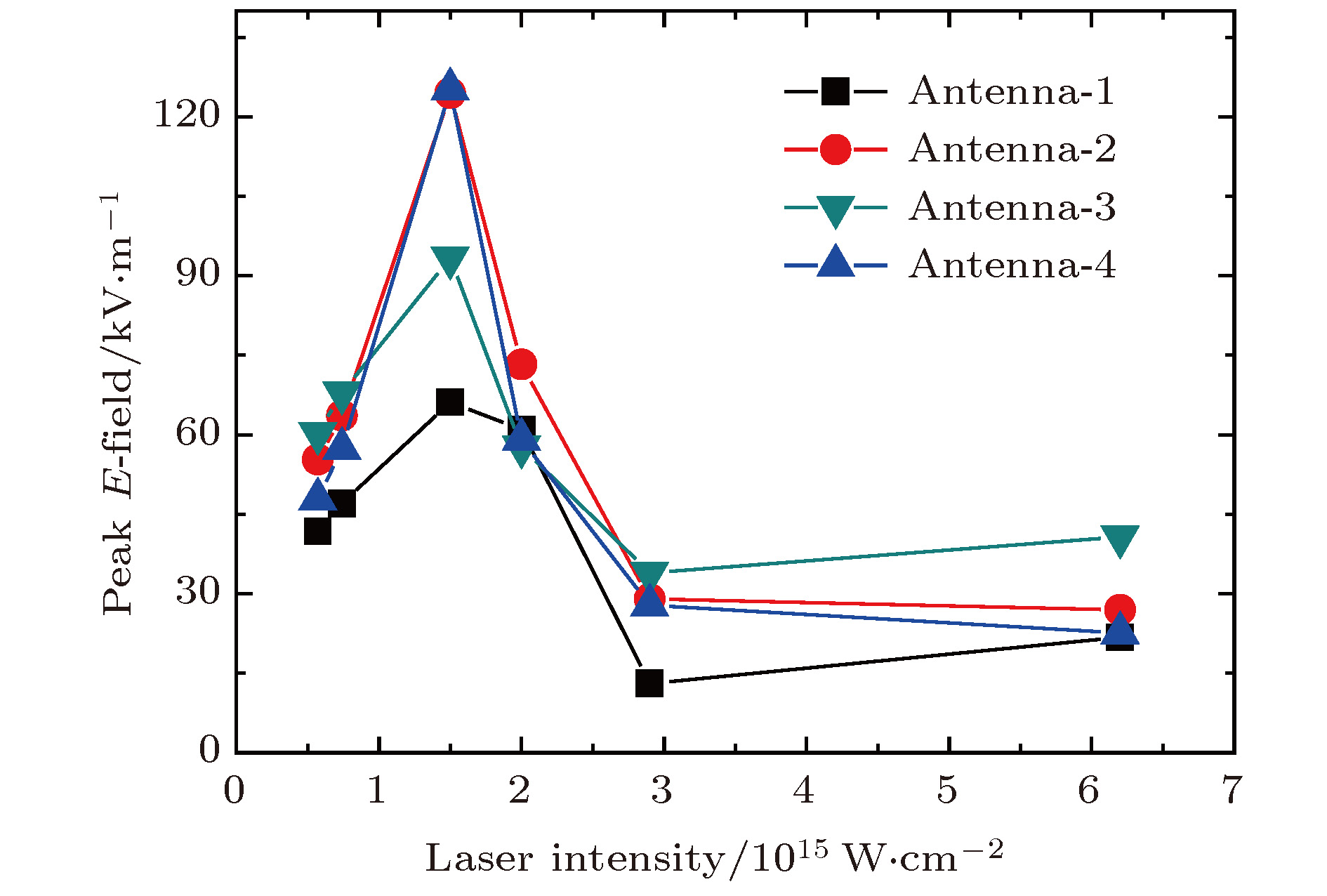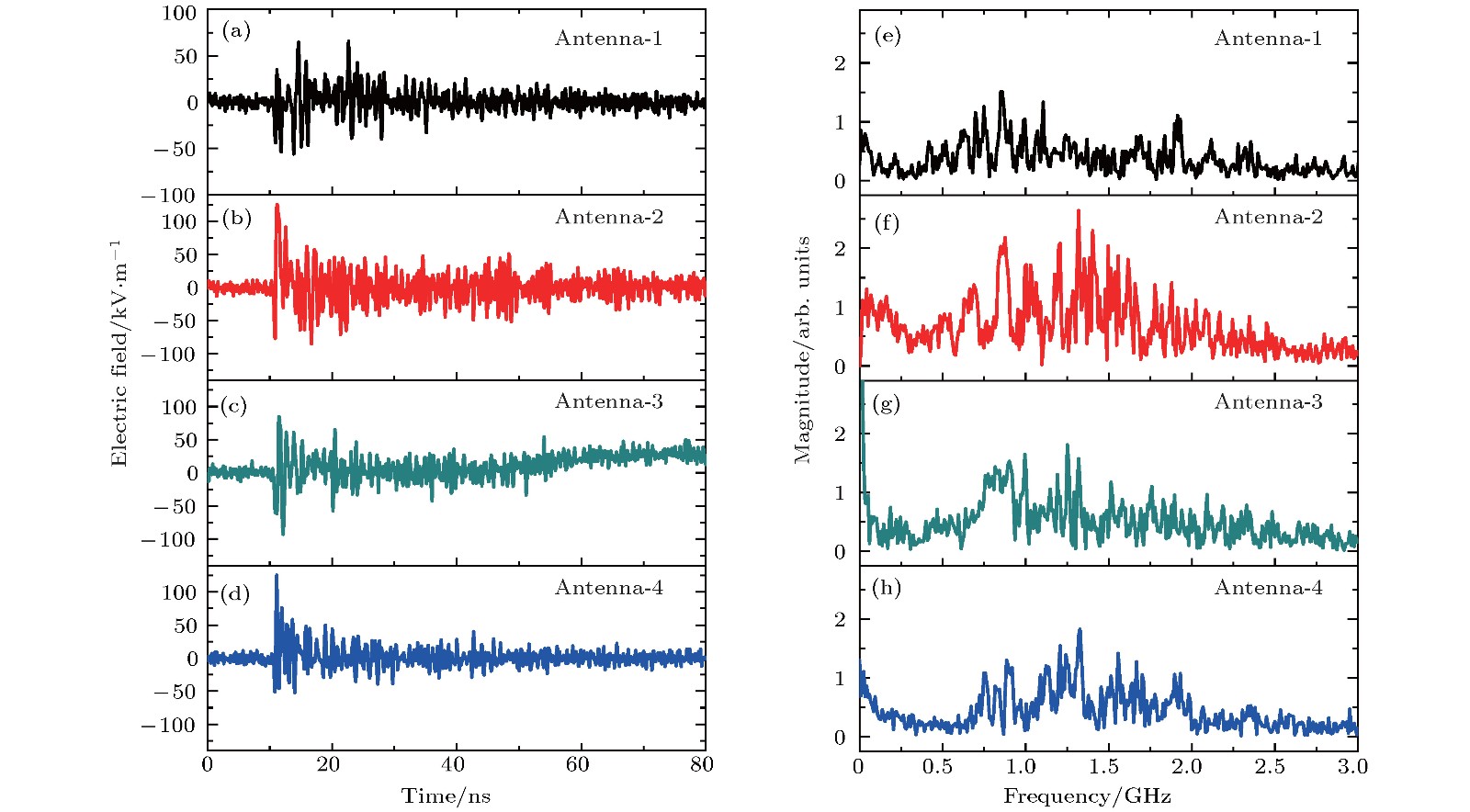-
Microwave radiation in several gigahertz frequency band is a common phenomenon in laser-plasma interactions. It can last hundreds of nanoseconds and cause huge electromagnetic pulse disturbances to electrical devices in experiments. It has been found that the microwave radiation might originate from the oscillation of charged chambers, the return current on target holders, the dipole radiation, the quadrupole radiation, and the electron bunch emitted from the plasma to the vacuum. The microwave radiation waveform, frequency spectrum, and intensity depend on many factors such as laser pulse, target, and chamber parameter. To distinguish the microwave radiation mechanisms, the influence of the experimental parameters on the radiation characteristics should be investigated systematically. In this paper we investigate the microwave radiation influenced by the laser intensity in nanosecond laser-plasma interactions. It is found that the microwave radiation intensity varies nonmonotonically with the laser intensity. For the lower laser intensity, the radiation intensity first increases and then decreases with laser intensity increasing, the radiation field continuously oscillates in tens of nanoseconds, and the radiation spectrum contains two components below and above 0.3 GHz, respectively. For the higher laser intensity, the radiation intensity increases with the laser intensity increasing, the radiation field has a unipolar radiation lasting tens of nanoseconds, and the radiation spectrum mainly includes the component below 0.3 GHz. The waveform and spectrum analysis show that these phenomena are due to the difference of the radiation mechanisms at different laser intensities. The frequency component below and above 0.3 GHz are induced by the electron bunch emitted from the plasma to the vacuum and the dipole radiation respectively. At low laser intensity, both the dipole radiation and the electron bunch emitted from the plasma contribute to the microwave radiation. At high laser intensity, the microwave radiation is mainly produced by the electron beam emitted from the plasma to the vacuum. This work is significant for understanding the microwave radiation mechanisms in nanosecond laser-plasma interactions, and implies the potential to provide a reference to the diagnosing of the escape electrons and the sheath field on the target surface by the microwave radiation in laser-plasma interaction.
-
Keywords:
- intense laser /
- microwave radiation /
- electromagnetic disturbance /
- nanosecond laser plasma
[1] Campbell E M, Goncharov V N, Sangster T C, Regan S P, Radha P B, Betti R, Myatt J F, Froula D H, Rosenberg M J, Igumenshchev I V, Seka W, Solodov A A, Maximov A V, Marozas J A, Collins T J B, Turnbull D, Marshall F J, Shvydky A, Knauer J P, McCrory R L, Sefkow A B, Hohenberger M, Michel P A, Chapman T, Masse L, Goyon C, Ross S, Bates J W, Karasik M, Oh J, Weaver J, Schmitt A J, Obenschain K, Obenschain S P, Reyes S, Wonterghem V 2017 Matter Radiat. Extremes 2 37
 Google Scholar
Google Scholar
[2] Snavely R A, Key M H, Hatchett S P, Cowan T E, Roth M, Phillips T W, Stoyer M A, Henry E A, Sangster T C, Singh M S, Wilks S C, MacKinnon A, Offenberger A, Pennington D M, Yasuike K, Langdon A B, Lasinski B F, Johnson J, Perry M D, Campbell E M 2000 Phys. Rev. Lett. 85 2945
 Google Scholar
Google Scholar
[3] Mangles S P D, Murphy C D, Najmudin Z, Thomas A G R, Collier J L, Dangor A E, Divall E J, Foster P S, Gallacher J G, Hooker C J, Jaroszynski D A, Langley A J, Mori W B, Norreys P A, Tsung F S, Viskup R, Walton B R, Krushelnick K 2004 Nature 431 535
 Google Scholar
Google Scholar
[4] Phuoc K T, Corde S, Thaury C, Malka V, Tafzi A, Goddet J P, Shah R C, Sebban S, Rousse A 2012 Nat. Photon. 6 308
 Google Scholar
Google Scholar
[5] Rousse A, Phuoc K T, Shah R, Pukhov A, Lefebvre E, Malka V, Kiselev S, Burgy F, Rousseau J, Umstadter D, Hulin D 2004 Phys. Rev. Lett. 93 135005
 Google Scholar
Google Scholar
[6] Liao G, Li Y, Liu H, Scott G G, Neely D, Zhang Y, Zhu B, Zhang Z, Armstrong C, Zemaityte E, Bradford P, Huggard P G, Rusby, D R, McKenna P, Brenner C M, Woolsey N C, Wang W, Sheng Z, Zhang J 2019 Proc. Natl. Acad. Sci. USA 116 3994
 Google Scholar
Google Scholar
[7] Robinson T S, Consoli F, Giltrap S, Eardley S J, Hicks G S, Ditter E J, Ettlinger O, Stuart N H, Notley M, de Angelis R, Najmudin Z, Smith R A 2017 Sci. Rep. 7 983
 Google Scholar
Google Scholar
[8] Meng C, Xu Z Q, Jiang Y S, Zheng W G, Dang Z 2017 IEEE Trans. Nucl. Sci. 64 10
 Google Scholar
Google Scholar
[9] Pearlman J S, Dahlbacka G H 1978 J. Appl. Phys. 49 457
 Google Scholar
Google Scholar
[10] Gerdin G, Tanis M J, Venneri F 1986 Plasma Phys. Control. Fusion 28 527
 Google Scholar
Google Scholar
[11] Mead M J, Neely D, Gauoin J, Heathcote R, Patel P 2004 Rev. Sci. Instrum. 75 4225
 Google Scholar
Google Scholar
[12] Raimbourg J 2004 Rev. Sci. Instrum. 75 4234
 Google Scholar
Google Scholar
[13] Felber F S 2005 Appl. Phys. Lett. 86 231501
 Google Scholar
Google Scholar
[14] Remo J L, Adams R G, Jones M C 2007 Appl. Opt. 46 6166
 Google Scholar
Google Scholar
[15] Miragliotta J, Brawley B, Sailor C, Spicer J B, Spicer J W M 2011 Proc. SPIE 8037 80370N-1
 Google Scholar
Google Scholar
[16] Chen Z Y, Li J F, Yu Y, Wang J X, Li X Y, Peng Q X, Zhu W J 2012 Phys. Plasmas 19 113116
 Google Scholar
Google Scholar
[17] 戴宇佳, 宋晓伟, 高勋, 王兴生, 林景全 2017 66 185201
 Google Scholar
Google Scholar
Dai Y J, Song X W, Gao X, Wang X S, Lin J Q 2017 Acta Phys. Sin. 66 185201
 Google Scholar
Google Scholar
[18] Englesbe A, Elle J, Reid R, Lucero A, Pohle H, Domonkos M, Kalmykov S, Krushelnick K, Schmitt-Sody A 2018 Opt. Lett. 43 4953
[19] Brown C G, Bond E, Clancy T, Dangi S, Eder D C, Ferguson W, Kimbrough J, Throop A 2010 J. Phys.: Conf. Ser. 244 032001
 Google Scholar
Google Scholar
[20] Tao Y, Yang M, Wang C, Yang W, Li Y, Liu S, Jiang S, Ding Y, Xiao S 2016 Photon. Sens. 6 249
 Google Scholar
Google Scholar
[21] Bradford P, Woolsey N C, Scott G G, Liao G, Liu H, Zhang Y, Zhu B, Armstrong C, Astbury S, Brenner C, Brummitt P, Consoli F, East I, Gray R, Haddock D, Huggard P, Jones P J R, Montgomery E, Musgrave I, Oliveira P, Rusby D R, Spindloe C, Summers B, Zemaityte E, Zhang Z, Li Y, McKenna P, Neely D 2018 High Power Laser Sci. Eng. 6 e21
 Google Scholar
Google Scholar
[22] Brown C G, Ayers J, Felker B, Ferguson W, Holder J P, Nagel S R, Piston K W, Simanovskaia N, Throop A L, Chung M, Hilsabeck T 2012 Rev. Sci. Instrum. 83 10D729
 Google Scholar
Google Scholar
[23] Brown C G, Clancy T J, Eder D C, Ferguson W, Throop A L 2013 EPJ Web of Conferences 59 08012
 Google Scholar
Google Scholar
[24] Consoli F, de Angelis R, de Marco M, Krasa J, Cikhardt J, Pfeifer M, Margarone D, Klir D, Dudzak R 2018 Plasma Phys. Control. Fusion 60 105006
 Google Scholar
Google Scholar
[25] Chen Z Y, Li J F, Li J, Peng Q X 2011 Plasma Scr. 83 055503
[26] Consoli F, de Angelis R, Duvillaret L, Andreoli P L, Cipriani M, Cristofari G, Di Giorgio G, Ingenito F, Verona C 2016 Sci. Rep. 6 27889
 Google Scholar
Google Scholar
[27] Krása J, de Marco M, Cikhardt J, Pfeifer M, Velyhan A, Klír D, Řezáč K, Limpouch J, Krouský E, Dostál J, Ullschmied J, Dudžák R 2017 Plasma Phys. Control. Fusion 59 065007
 Google Scholar
Google Scholar
-
图 3 入射激光强度分别为(a) 5.7 × 1014, (b) 7.4 × 1014, (c) 1.5 × 1015, (d) 2.0 × 1015, (e) 2.9 × 1015, (f) 6.2 × 1015 W/cm2时, 靶前靠近法线方向上的电场时间波形
Figure 3. Electric field waveforms detected by the monopole antenna-3 at laser intensities of (a) 5.7 × 1014, (b) 7.4 × 1014, (c) 1.5 × 1015, (d) 2.0 × 1015, (e) 2.9 × 1015, and (f) 6.2 × 1015 W/cm2.
图 4 入射激光强度分别为(a) 5.7 × 1014, (b) 7.4 × 1014, (c) 1.5 × 1015, (d) 2.0 × 1015, (e) 2.9 × 1015, (f) 6.2 × 1015 W/cm2时, 靶前靠近法线方向上电场的频谱分布
Figure 4. Frequency spectra of the electric fields detected by the monopole antenna-3 at laser intensities of (a) 5.7 × 1014, (b) 7.4 × 1014, (c) 1.5 × 1015, (d) 2.0 × 1015, (e) 2.9 × 1015, and (f) 6.2 × 1015 W/cm2.
图 5 入射激光强度为1.5 × 1015 W/cm2时, 不同方向测量的电场波形及其频谱分布 (a)和(e)对应单极天线-1; (b)和(f)对应单极天线-2; (c)和(g)对应单极天线-3; (d)和(h)对应单极天线-4
Figure 5. Electric field waveforms and their corresponding frequency spectra detected by the four monopole antennas. (a) and (e) correspond to the monopole antenna-1, (b) and (f) correspond to the monopole antenna-2, (c) and (g) correspond to the monopole antenna-3, (d) and (h) correspond to the monopole antenna-4. The laser intensity is 1.5 × 1015 W/cm2.
图 6 入射激光强度为6.2 × 1015 W/cm2时, 不同方向测量的电场波形及其频谱分布 (a)和(e)对应单极天线-1; (b)和(f)对应单极天线-2; (c)和(g)对应单极天线-3; (d)和(h)对应单极天线-4
Figure 6. Electric field waveforms and their corresponding frequency spectra detected by the four monopole antennas. (a) and (e) correspond to the monopole antenna-1, (b) and (f) correspond to the monopole antenna-2, (c) and (g) correspond to the monopole antenna-3, (d) and (h) correspond to the monopole antenna-4. The laser intensity is 6.2 × 1015 W/cm2.
图 7 不同方向测量的微波辐射能量随激光强度的变化(a)单位立体角内产生的总辐射能; (b)单位立体角内产生的0.3 GHz以下的辐射能; (c)单位立体角内产生的0.3 GHz以上的辐射能
Figure 7. Radiation energy versus laser intensity at different directions: (a) Total radiation energy detected by the antennas; (b) radiation energy at frequencies lower than 0.3 GHz; (c) radiation energy at frequencies upper than 0.3 GHz.
-
[1] Campbell E M, Goncharov V N, Sangster T C, Regan S P, Radha P B, Betti R, Myatt J F, Froula D H, Rosenberg M J, Igumenshchev I V, Seka W, Solodov A A, Maximov A V, Marozas J A, Collins T J B, Turnbull D, Marshall F J, Shvydky A, Knauer J P, McCrory R L, Sefkow A B, Hohenberger M, Michel P A, Chapman T, Masse L, Goyon C, Ross S, Bates J W, Karasik M, Oh J, Weaver J, Schmitt A J, Obenschain K, Obenschain S P, Reyes S, Wonterghem V 2017 Matter Radiat. Extremes 2 37
 Google Scholar
Google Scholar
[2] Snavely R A, Key M H, Hatchett S P, Cowan T E, Roth M, Phillips T W, Stoyer M A, Henry E A, Sangster T C, Singh M S, Wilks S C, MacKinnon A, Offenberger A, Pennington D M, Yasuike K, Langdon A B, Lasinski B F, Johnson J, Perry M D, Campbell E M 2000 Phys. Rev. Lett. 85 2945
 Google Scholar
Google Scholar
[3] Mangles S P D, Murphy C D, Najmudin Z, Thomas A G R, Collier J L, Dangor A E, Divall E J, Foster P S, Gallacher J G, Hooker C J, Jaroszynski D A, Langley A J, Mori W B, Norreys P A, Tsung F S, Viskup R, Walton B R, Krushelnick K 2004 Nature 431 535
 Google Scholar
Google Scholar
[4] Phuoc K T, Corde S, Thaury C, Malka V, Tafzi A, Goddet J P, Shah R C, Sebban S, Rousse A 2012 Nat. Photon. 6 308
 Google Scholar
Google Scholar
[5] Rousse A, Phuoc K T, Shah R, Pukhov A, Lefebvre E, Malka V, Kiselev S, Burgy F, Rousseau J, Umstadter D, Hulin D 2004 Phys. Rev. Lett. 93 135005
 Google Scholar
Google Scholar
[6] Liao G, Li Y, Liu H, Scott G G, Neely D, Zhang Y, Zhu B, Zhang Z, Armstrong C, Zemaityte E, Bradford P, Huggard P G, Rusby, D R, McKenna P, Brenner C M, Woolsey N C, Wang W, Sheng Z, Zhang J 2019 Proc. Natl. Acad. Sci. USA 116 3994
 Google Scholar
Google Scholar
[7] Robinson T S, Consoli F, Giltrap S, Eardley S J, Hicks G S, Ditter E J, Ettlinger O, Stuart N H, Notley M, de Angelis R, Najmudin Z, Smith R A 2017 Sci. Rep. 7 983
 Google Scholar
Google Scholar
[8] Meng C, Xu Z Q, Jiang Y S, Zheng W G, Dang Z 2017 IEEE Trans. Nucl. Sci. 64 10
 Google Scholar
Google Scholar
[9] Pearlman J S, Dahlbacka G H 1978 J. Appl. Phys. 49 457
 Google Scholar
Google Scholar
[10] Gerdin G, Tanis M J, Venneri F 1986 Plasma Phys. Control. Fusion 28 527
 Google Scholar
Google Scholar
[11] Mead M J, Neely D, Gauoin J, Heathcote R, Patel P 2004 Rev. Sci. Instrum. 75 4225
 Google Scholar
Google Scholar
[12] Raimbourg J 2004 Rev. Sci. Instrum. 75 4234
 Google Scholar
Google Scholar
[13] Felber F S 2005 Appl. Phys. Lett. 86 231501
 Google Scholar
Google Scholar
[14] Remo J L, Adams R G, Jones M C 2007 Appl. Opt. 46 6166
 Google Scholar
Google Scholar
[15] Miragliotta J, Brawley B, Sailor C, Spicer J B, Spicer J W M 2011 Proc. SPIE 8037 80370N-1
 Google Scholar
Google Scholar
[16] Chen Z Y, Li J F, Yu Y, Wang J X, Li X Y, Peng Q X, Zhu W J 2012 Phys. Plasmas 19 113116
 Google Scholar
Google Scholar
[17] 戴宇佳, 宋晓伟, 高勋, 王兴生, 林景全 2017 66 185201
 Google Scholar
Google Scholar
Dai Y J, Song X W, Gao X, Wang X S, Lin J Q 2017 Acta Phys. Sin. 66 185201
 Google Scholar
Google Scholar
[18] Englesbe A, Elle J, Reid R, Lucero A, Pohle H, Domonkos M, Kalmykov S, Krushelnick K, Schmitt-Sody A 2018 Opt. Lett. 43 4953
[19] Brown C G, Bond E, Clancy T, Dangi S, Eder D C, Ferguson W, Kimbrough J, Throop A 2010 J. Phys.: Conf. Ser. 244 032001
 Google Scholar
Google Scholar
[20] Tao Y, Yang M, Wang C, Yang W, Li Y, Liu S, Jiang S, Ding Y, Xiao S 2016 Photon. Sens. 6 249
 Google Scholar
Google Scholar
[21] Bradford P, Woolsey N C, Scott G G, Liao G, Liu H, Zhang Y, Zhu B, Armstrong C, Astbury S, Brenner C, Brummitt P, Consoli F, East I, Gray R, Haddock D, Huggard P, Jones P J R, Montgomery E, Musgrave I, Oliveira P, Rusby D R, Spindloe C, Summers B, Zemaityte E, Zhang Z, Li Y, McKenna P, Neely D 2018 High Power Laser Sci. Eng. 6 e21
 Google Scholar
Google Scholar
[22] Brown C G, Ayers J, Felker B, Ferguson W, Holder J P, Nagel S R, Piston K W, Simanovskaia N, Throop A L, Chung M, Hilsabeck T 2012 Rev. Sci. Instrum. 83 10D729
 Google Scholar
Google Scholar
[23] Brown C G, Clancy T J, Eder D C, Ferguson W, Throop A L 2013 EPJ Web of Conferences 59 08012
 Google Scholar
Google Scholar
[24] Consoli F, de Angelis R, de Marco M, Krasa J, Cikhardt J, Pfeifer M, Margarone D, Klir D, Dudzak R 2018 Plasma Phys. Control. Fusion 60 105006
 Google Scholar
Google Scholar
[25] Chen Z Y, Li J F, Li J, Peng Q X 2011 Plasma Scr. 83 055503
[26] Consoli F, de Angelis R, Duvillaret L, Andreoli P L, Cipriani M, Cristofari G, Di Giorgio G, Ingenito F, Verona C 2016 Sci. Rep. 6 27889
 Google Scholar
Google Scholar
[27] Krása J, de Marco M, Cikhardt J, Pfeifer M, Velyhan A, Klír D, Řezáč K, Limpouch J, Krouský E, Dostál J, Ullschmied J, Dudžák R 2017 Plasma Phys. Control. Fusion 59 065007
 Google Scholar
Google Scholar
Catalog
Metrics
- Abstract views: 18611
- PDF Downloads: 117
- Cited By: 0















 DownLoad:
DownLoad:






